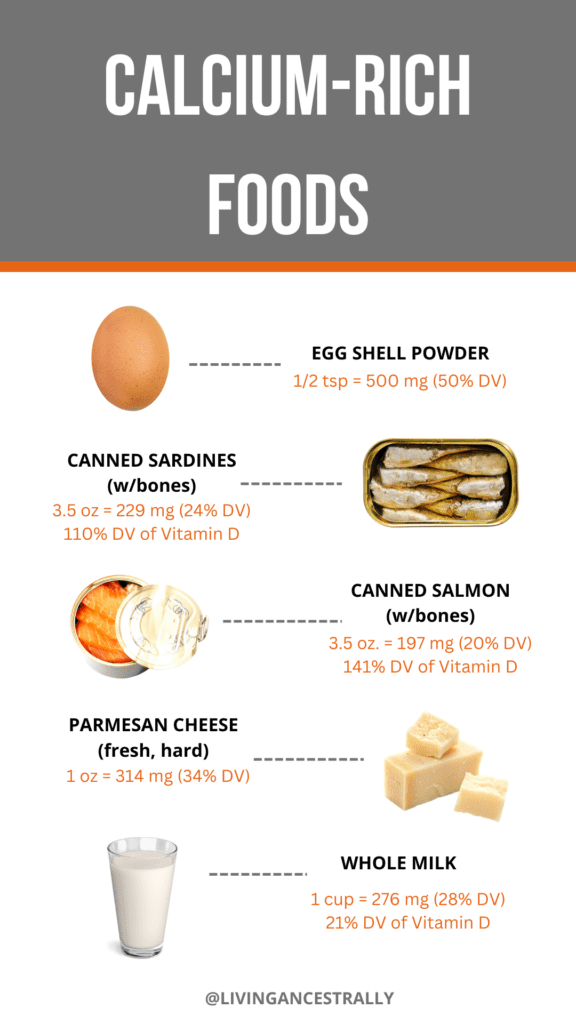Absorbing Calcium From Our Foods
Most people who consume dairy are getting plenty of calcium. The problem is that many of us are not getting the cofactors that allow calcium to be absorbed by the body.
This causes a lot of issues.
It can be harmful to have a high amount of free-flowing calcium in our blood and to have calcium taken away from our bones. Some calcium in our blood is a good thing because it helps with blood clotting, among other things.
High levels of free-flowing calcium though can cause cardiovascular issues.
Thankfully, it’s pretty easy to keep calcium in check. Keep reading to find out how.

Can Calcium Levels Be Tested?
Calcium levels in the blood are not a good indicator of calcium levels in the bones and tissues.
The bones and the tissues are where we want 99% of calcium to be so that these parts of our body are strong and healthy.
A DEXA scan or a hair tissue mineral analysis (HTMA) are more reliable tests for calcium levels. These tests have their flaws too, but it’s good to get a variety of data to evaluate your health.
As far as testing a child’s calcium level goes, it’s usually unnecessary, but to see calcium levels in the hair and tissue then a HTMA is usually done. A hair sample from the scalp is all that is needed in this case. No blood draw is required.
HTMA is a tool that is not definitive, however, it does look at mineral as well as heavy metal levels in the hair and tissues to see if there is an imbalance or overload. An HTMA may be beneficial if your child has any health issues, including extreme hyperactivity, sleep struggles, chronic skin rashes, consistent extreme emotional outbursts, or any other negative chronic issue.
If you notice any of above things then there could be an imbalance going on that can usually be corrected. However, it’s important to test to get more of an idea of what is actually imbalanced.
What are the Calcium Cofactors?
💎 Minerals
Magnesium, sodium, and potassium are cofactors of calcium. They are necessary for calcium to work properly. Phosphorus is important to keep in check. Too much phosphorus can cause calcium to be drawn out from the bones in order to keep phosphorus levels low enough.
💦 Electrolytes In Your Water
Electrolytes used to be found in abundance in ancestral people’s water supply. Well, they aren’t anymore. Instead, tap water is full of heavy metals, pesticides, other people’s medications, hormone-altering chemicals, and more.
If you use a reverse osmosis water filter then you need to add electrolytes back to your water. Reverse osmosis filters do a great job of removing anything in dirty water, including healthy electrolytes.
☀️ Vitamin D
Vitamin D is an important nutrient to get enough of to ensure our bodies use calcium properly. Vitamin D from sunlight is the top source of vitamin D. Some foods such as egg yolks, milk, cheese, yogurt, kefir, sardines, and salmon provide additional sources of vitamin D. Fat is necessary for our bodies to absorb vitamin D.
Depending on your skin color, just 10-20 minutes of mid-day sunlight several times a day is sufficient to ensure our bodies activate the vitamin D that’s already within our tissues.
🍳 Vitamin K2
This vitamin can optimize calcium use in the body. Vitamin K2 can help ensure that there is no free flowing calcium the body. Food sources of vitamin K2 include sauerkraut, kefir, whole food dairy, chicken breast, gouda, and egg yolks.
🧬 Parathyroid Gland
The parathyroid gland is a set of four tiny glands that lie behind the thyroid gland. The parathyroid glands produce a hormone that helps keep calcium blood levels in check.
👌🏼 Healthy Gut
Our digestive organs need to be working properly in order to ensure that we are breaking down the nutrients we are eating as well as making sure they are actually being absorbed.
Digestive enzymes can help for a period of time, while you work on improving your gut health.
🐠 Omega Fatty Acids
Fatty acids from fish are the most ideal. However, it’s beneficial to eat different sources of fat to get a variety of fatty acids in your diet.
Eating a variety of meat – not just beef or just chicken – is ideal for ensuring we are getting a variety of fats because the nutrient profiles in different meats are different. For instance, beef is a poor source of bioavailable thiamine (vitamin B1) but pork is an excellent source. Here’s another example, canned fish (with bones) is high in calcium whereas beef is not.
The point is: you’ll feel better if you eat a variety of meat sources.

How Do We Ensure Our Kids Are Getting Enough Calcium?
💪🏼 Calcium is especially important for our growing children. But they need to actually be getting enough calcium, as well as it, actually being absorbed into the bones.
🥛 Milk is not a sufficient source of calcium – at least not on its own. It’s a wonderful supplemental source, especially raw milk. But 1 cup of milk only provides 276 mg of calcium (28% DV).
Picking a wide variety of whole foods from the graphic below for your WHOLE family is ideal so that you are also getting calcium from different sources, as well as getting the important calcium cofactors. Of course, there are other calcium-rich foods that aren’t in the graphic.
🐟 My favorite calcium sources are fatty fish (with bones) and eggshells.
🍳 If you already eat lots of eggs at your home, it’s really easy to make eggshell powder.

How Much Calcium Is Ideal?
The RDA is 1,000-1,200 mg a day for adults. For children, it’s 700-1,300, depending on their age.
On average, the human body is only able to absorb around 500 mg of calcium at one time. Spreading out your daily intake throughout the day is ideal.
What Does Our Family Do for Calcium?
We eat seafood high in calcium (like salmon, sardines, or anchovies) three to four times a week.
Raw dairy is another source of calcium in our home, but we also always have some eggshell powder on hand.
I make eggshell powder each week from our used eggshells. I encourage you to save your eggshells and make some eggshell powder! I’ll share more on how this process works soon.
I will consume a tsp of eggshell powder when I don’t eat a meal that is sufficient in calcium. A teaspoon of eggshell powder has approximately 500 mg of calcium.
My biggest tip is to make sure that you and your family are consuming a good food source of calcium at each meal. Of course, focusing on getting all of the calcium cofactors is also important to ensure you are absorbing the calcium you are consuming.
Please note that A Hair Mineral Analysis (HTMA) is not intended to diagnose, treat, cure, reverse, or prevent any disease. It is not intended to replace any other medical test(s) that may be prescribed by your medical doctor.
